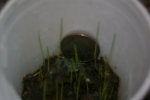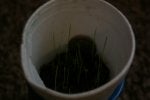i think the bigger issue is tiny sprouts being trampled by mowers and feet. a week after sowing there could be many sprouts that got torn up.
if you mulched though, my theory at least, is that the tiny sprouts are so small that when the green mulched grass decomposes it can also take out those tiny sprouts with it, sort of like composting.
But, my theory is if you mulch over fresh new seed, in about a week it'll take those clippings to turn brown and stop decomposing and be no threat, that's about when the new grass will sprout and no problem there.
I do think even if bagging some seed can get sucked up too though for sure. I don't mow for a while after seeding but I try to not break the 1/3 rule too much because you do want a low final cut so a) stray leaves that fall very late in Fall or blow from somewhere else don't get stuck and embedded in lawn as easily, and b) you want a quick Spring green up to help prevent weeds and if you just break the 1/3 rule heavily before winter you'll leave a 'stump' of the grass that won't green up as fast as if it were gradually brought down low.
Prior to seed, I cut and bag on a low or lowest setting also, that gives the new grass sun to grow and existing grass won't be so tall when it's time to take a mower to it all.
Anyway, she shoulda put a small sign out like a leaf bag "overseeded, do not mow until **/**/**." but if communication error on either part I'd just throw down more seed now and/or Spring and it'll all grow fine.






